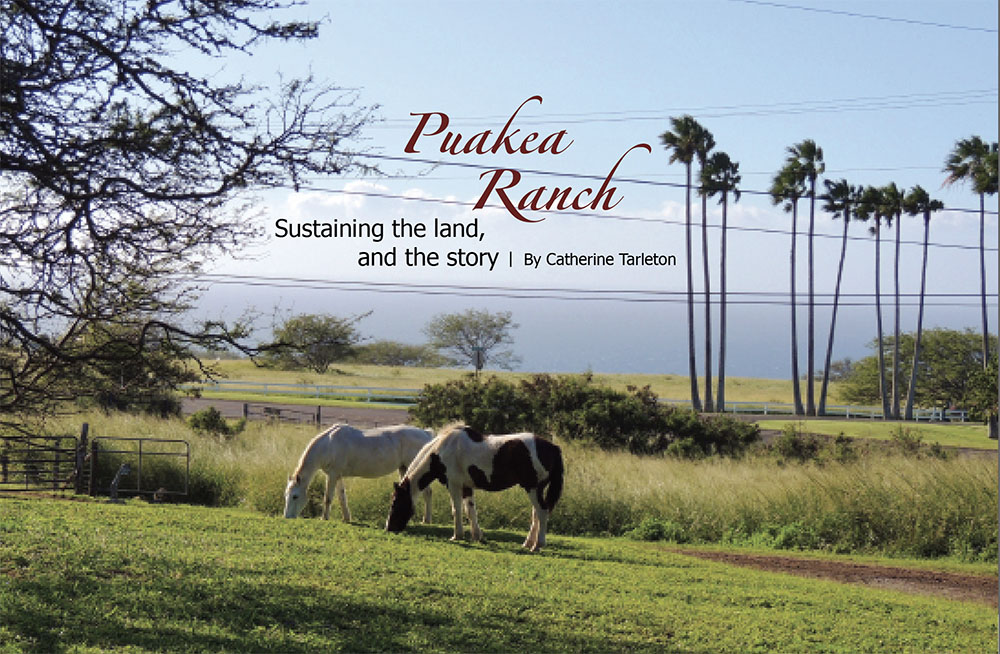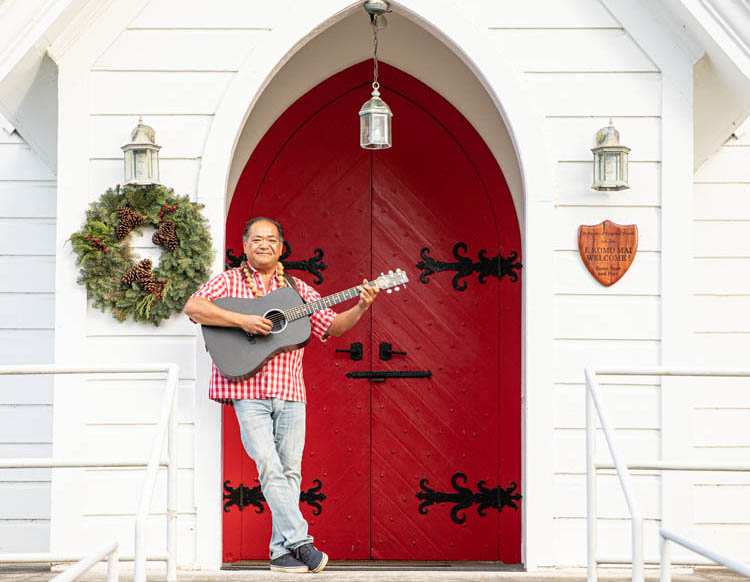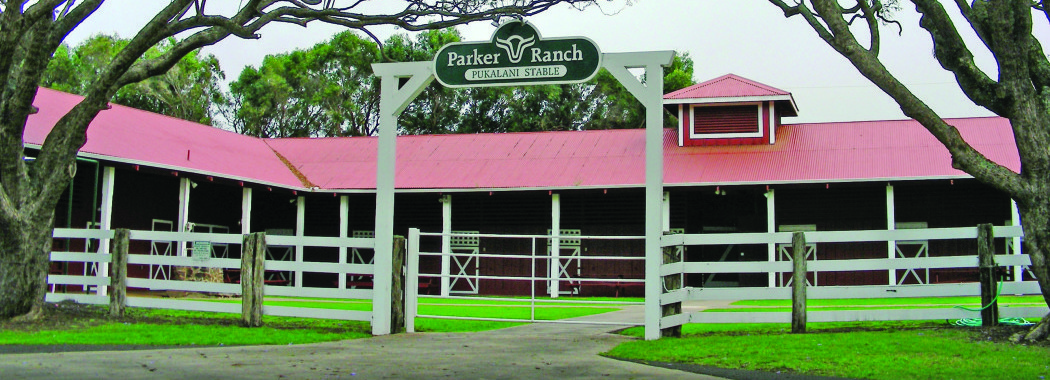
Puakea Ranch: Sustaining the Land, and the Story

By Catherine Tarleton
The high green hills of North Kohala have evolved over generations, from forests and farms to blankets of sugar cane and rolling ranch country. As do most places here, Puakea Ranch has a story to tell in its current incarnation as a lovingly restored vacation homestead of paniolo cottages, 100-year-old trees, horses, goats, laying hens, and even a friendly resident pig.
At Puakea, influences of many cultures—from old Hawaiian, European, American, and Japanese—blend into one like a rich garden, fragrant, colorful, and nourishing. Surrounded by pasture overlooking the ocean, a rope swing beckons from a tall shade tree, curious chickens mutter, and three imperturbable horses graze. Visitors step into a very different place and time.
Puakea has deep roots in the Kohala District, reaching back more than 1,000 years. These lands were part of the centuries-old Kohala Field System, studied by early explorers and applauded for its terracing of the land to maximize rainfall and prevent soil erosion. Farming families may have lived here for generations growing sweet potatoes, dryland taro, bananas, breadfruit, and more.
Not far away, Kamehameha I was born in 1758, the year Halley’s Comet enlightened the night sky as a hō‘ailona, a natural sign or omen. As king, Kamehameha eventually controlled and united all the islands under one rule. Thus, Kohala was his and passed down to his descendants until 1870, when a shipwreck off Māhukona brought the Wight family to Kohala and with them the next chapter of both Puakea and Hawaiian history.
A gentleman of Scotch-Irish lineage, born in India and schooled at the University of Edinburgh, Dr. James Wight practiced medicine in Australia before setting sail to California for the Gold Rush. Shipwrecked off Māhukona, Wight and his very pregnant wife struggled to shore. Sadly, their 13-month-old daughter was drowned, and Mrs. Wight gave birth that same night, in a grass-thatched hut with their daughter’s body in the next room.

After a tragic beginning, the Wights made a home in Kohala and raised six children. The doctor opened a shop and pharmacy and served as a community leader, postmaster, circuit judge, representative to the territorial government, and member of the house of nobles. Wight eventually bought Puakea from Kamehameha’s granddaughter. He planted sugar cane, built a processing mill, and began raising cattle, as well. As did most planters at the time, Wight brought in laborers—part of a wave of 185,000 Japanese immigrants in the late 19th and early 20th Century.
The wave included Zenjiro Kawamoto and wife Wasa Watabayashi from Hiroshima. They moved into what is today called the “Cowboy House.” They converted it into a bunkhouse for single men, with a separate cookhouse, privy, and bathing house with a traditional Japanese furo tub.
The Kawamotos raised three children at Puakea: Yoshi, Masa, and Thelma, who grew up with other paniolo families. The Kawamotos oversaw Ranch operations for four generations.
More cottages sprang up and Yoshi built his own home (now “Yoshi’s House”) in the 1940s, about the same time Parker Ranch purchased Puakea. In the 1980s, they sold Puakea and some 200 acres to a local developer who planned a subdivision. Things changed. The Kawamoto family and others moved away. Though some of the cottages were rented out, Puakea was all but forgotten.
Then in 2005, Christie Cash, owner-operator of a successful post-production studio in Los Angeles, was driven by her self-proclaimed love affair with Hawai‘i to look for a unique piece of real estate. Her idea was to create a “low impact, eco-minded, low-density place for families that was an alternative to the resorts.”
While viewing a nearby property, Christie caught her first glimpse of Puakea’s tree-lined drive and graceful rock walls. She found and contacted the owner, asked for a walk-through, and the next chapter was underway.
“It was nearly abandoned,” says Christie. “I got to walk around and go in the little houses… I was completely taken. My vision adapted to the property.”
Christie says that consultants and contractors encouraged her to bulldoze the cottages and start over. Friends also had doubts: giving up a prosperous career, uprooting two children and her commercial editor husband Jay Nelson for a falling down cowboy compound on Hawai‘i Island. Undeterred, they moved forward. By the next term, both kids were enrolled in Hawai‘i Preparatory Academy, Jay was commuting back to the West Coast for work, and Christie was knee-deep in restoration.
“It needed so much work, so much historical research,” says Christie. “I gave my time to talk about the land, experience the land, and adapt the vision based on the land.”
Part of her research included meetings with the North Kohala Community Resource Center as to what would make the community happy with the historic property. She was introduced to Margaret Kawamoto, Yoshi’s wife, who gave Christie copies of family photos, and relived stories of happy days at the Ranch.
“I have so much love and respect for her,” says Christie.
Deciding to keep Puakea, Puakea as much as possible, she went to great lengths to restore every square inch of roof, floors, walls, and more. Where it couldn’t be saved, it was replaced with recycled vintage materials from the same era and the same region, when possible.
In October 2007, Puakea Ranch welcomed its first guests into Yoshi’s House (two-bedroom with pool) and Cowboy House (three-bedroom with hot tub). Later, they would open the intimate “James Cottage” suite with hot tub and “Miles Away,” a spacious two-bedroom with large lanai, punee, plunge pool, and waterfall.
Perhaps inspired by her movie background, Christie immaculately detailed the bungalows, allowing fantasy to play out in crafted stage settings rather than mere rooms. Four-poster beds, revitalized ranch kitchens, and cowhide rugs give a sense of place. Just inside the door of Yoshi’s House is a Hawaiian tree saddle—made by his brother Alvin—draped with leis. Family photos remind visitors they are between the walls of history.
Kids have the run of green lawns with swings and fruit trees plus the excitement of being around horses, goats, chickens, dogs, and a pig. Families can go swimming, pick herbs and vegetables from the community garden, or get fresh eggs from the bin at the chicken coop. And with more than a nod to modern convenience, each bungalow has high speed wireless Internet, telephone, cable television, and the “Toy Box,” a lending library of Legos and lots more.
If the Ranch bungalow is a work of art, the bathhouse is a masterpiece. Set within the footprint of the original, today’s bathhouses are updated with slate tile walls, smooth, pebbly floors, and elegant fixtures. Yoshi’s House has an indulgent copper tub for two and rainshower with ocean view; Miles Away has a modern Japanese two-person soaking tub. Crafted by a specialized carpenter, the bathhouses have rough-hewn wooden shelving and toiletry nooks and fixtures in wood and bamboo (some harvested from the property). Framed art, cushy, monogrammed towels, and locally made bath products add to the serenity of luxury-spa-meets-upcountry-rustic.
With brains as well as beauty, Puakea remains true to Christie’s vision for a low-impact, eco-minded resort alternative—applying sustainable practices from the past to the present. To save electricity, cottages are naturally cool, with no air-conditioning; energy-efficient lighting and appliances are used throughout. Yoshi’s House was the first to have solar power, with more planned, to enable the Ranch to transition completely “off grid.” Guests are encouraged to hang beach towels and swimsuits on their clotheslines—prepped with whimsically painted clothespins by a local folk artist.
Water is conserved with low-flow toilets, faucets, showers, and washing machines, and visitors participate by reasonably reusing bed and bath linens. Gray water is recycled in the gardens and landscaping, much of which is “xeriscaped,” using plants native to the region with lower water needs.
Cottages are equipped with recycling bins; sink-top composters; eco-friendly cleaning products and durable plates, cups, glasses, etc., as opposed to disposable. Christie and her team always recommend shopping at farmers markets in Hāwi and elsewhere for fresh local food and flowers to support both economy and environment. Additionally, some bath products, room accessories, art, and other items are purchased from island makers, connecting a visitor more closely with the community—whether they are entirely aware or not.
History, craftsmanship, and sustainability all nourish Christie’s vision and the remarkable sense of place at Puakea Ranch. Says Christie, “It’s really beautiful, and really simple. You can’t reproduce that. It doesn’t translate.”
Puakea Ranch is located just off Akoni Pule Highway in the North Kohala District, two miles south of Hāwi. ❖
Click for reservations or more information on line about Puakea Ranch or call 808-315-0805.


